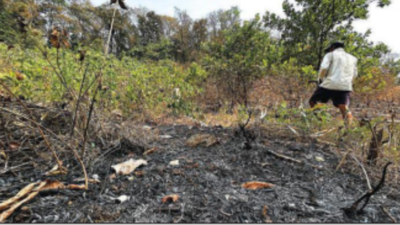Top Searches
'We didn't start the fire': Satre locals attribute flames to rising temperatures, 'will of god'

A resident of Satre walks through a destroyed cashew plantation
PANAJI: Winding through the evergreen forests of the Mhadei Wildlife Sanctuary, there is a sudden change of scenery as one approaches the settlement of Satre, deep inside the protected area.
Everywhere you look, there are horticultural plantations in sight - betelnut, cashew, pepper, papaya, banana. At the centre of the plantations is a group of around 50-60 households. Here, it is difficult to believe you're still in the sanctuary.
Over the past eight days, the villagers saw fires starting from one of the cashew plantations and then blazing through the adjacent forests, scorching trees and all biodiversity along the way.
On Saturday, the Union environment ministry said that the Goa forest fires appear to be mostly man-made. But at Satre, the villagers believe otherwise.
"The fire started right on top of the hill, in a completely inaccessible area. Who would go up there to light the fire? It has been unusually hot this year since February, and the wind on the day the fires started was unusually strong. All one can say is that it must be God's will," said a Satre resident.
The Mhadei Wildlife Sanctuary was notified in 1999, and villagers in Satre, just like 'forest dwellers' in other parts of the sanctuary area, admit that as families have grown, so have households and plantations.
"Nobody thought of carrying out a survey of the houses and plantations at the time the sanctuary was notified and freezing the number so there are no further encroachments," said an environmentalist.
According to former range forest officer Prakash Salelkar, it is a common practice to light fires in cashew plantations in sanctuaries across Goa to deliberately degrade forests and expand encroachments by claiming forest rights. He, like other experts, differ from the contention of dwellers inside the Sanctuary that the rising temperature by itself can cause fires naturally.
In Satre, residents are now awaiting the state's assessment of losses to their cashew plantations.
"By the time my wife and daughter could douse the fire, we lost almost 200 to 300 cashew trees," said a local, unwittingly pointing to the extent of horticultural plantations of a single household inside the sanctuary.
"Once the villagers learnt of the fire, we immediately got together to douse the fire inside the cashew plantations. In the plantations, where the fire had not yet reached, we began clearing the leaf litter on the ground, which had not been cleared. This helped save some of the plantations," said a woman from Satre.
Although the villagers contained the fire within their plantations, the blaze continued in the adjoining forests, leaving it to the Indian Navy, the forest department, and volunteers to control the damage.
On Saturday, Satre villagers were seen sifting through the plantation ground to salvage the cashew pedicels still left intact after the fire. "We have lost the entire year's income (which we earn from selling the cashew pedicels)," said a villager.
In the background, the Satregad hill which towers over the settlement stood singed from the fire, the uprooted trees having left it clearly chipped and destabilised, even as villagers went about tending to their plantations, seemingly unaware of the impending danger.
Everywhere you look, there are horticultural plantations in sight - betelnut, cashew, pepper, papaya, banana. At the centre of the plantations is a group of around 50-60 households. Here, it is difficult to believe you're still in the sanctuary.
Over the past eight days, the villagers saw fires starting from one of the cashew plantations and then blazing through the adjacent forests, scorching trees and all biodiversity along the way.
On Saturday, the Union environment ministry said that the Goa forest fires appear to be mostly man-made. But at Satre, the villagers believe otherwise.
"The fire started right on top of the hill, in a completely inaccessible area. Who would go up there to light the fire? It has been unusually hot this year since February, and the wind on the day the fires started was unusually strong. All one can say is that it must be God's will," said a Satre resident.
The Mhadei Wildlife Sanctuary was notified in 1999, and villagers in Satre, just like 'forest dwellers' in other parts of the sanctuary area, admit that as families have grown, so have households and plantations.
"Nobody thought of carrying out a survey of the houses and plantations at the time the sanctuary was notified and freezing the number so there are no further encroachments," said an environmentalist.
According to former range forest officer Prakash Salelkar, it is a common practice to light fires in cashew plantations in sanctuaries across Goa to deliberately degrade forests and expand encroachments by claiming forest rights. He, like other experts, differ from the contention of dwellers inside the Sanctuary that the rising temperature by itself can cause fires naturally.
In Satre, residents are now awaiting the state's assessment of losses to their cashew plantations.
"By the time my wife and daughter could douse the fire, we lost almost 200 to 300 cashew trees," said a local, unwittingly pointing to the extent of horticultural plantations of a single household inside the sanctuary.
"Once the villagers learnt of the fire, we immediately got together to douse the fire inside the cashew plantations. In the plantations, where the fire had not yet reached, we began clearing the leaf litter on the ground, which had not been cleared. This helped save some of the plantations," said a woman from Satre.
Although the villagers contained the fire within their plantations, the blaze continued in the adjoining forests, leaving it to the Indian Navy, the forest department, and volunteers to control the damage.
On Saturday, Satre villagers were seen sifting through the plantation ground to salvage the cashew pedicels still left intact after the fire. "We have lost the entire year's income (which we earn from selling the cashew pedicels)," said a villager.
In the background, the Satregad hill which towers over the settlement stood singed from the fire, the uprooted trees having left it clearly chipped and destabilised, even as villagers went about tending to their plantations, seemingly unaware of the impending danger.

About the Author
Gauree MalkarnekarGauree Malkarnekar, senior correspondent at The Times of India, Goa, maintains a hawk's eye on Goa's expansive education sector. And when she is not chasing schools, headmasters and teachers, she turns her focus to crime. Her entry into journalism was purely accidental: a trained commercial artist, she landed her first job as a graphic designer with a weekly, but less than a fortnight later set aside the brush and picked up the pen. Ever since she has not complained.
Start a Conversation
FOLLOW US ON SOCIAL MEDIA
FacebookTwitterInstagramKOO APPYOUTUBE









